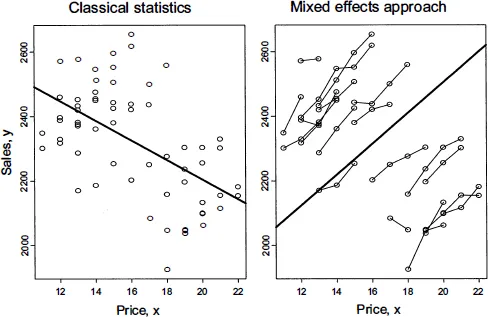
- English
- ePUB (mobile friendly)
- Available on iOS & Android
About this book
Praise for the First Edition
"This book will serve to greatly complement the growing number of texts dealing with mixed models, and I highly recommend including it in one's personal library."
—Journal of the American Statistical Association
Mixed modeling is a crucial area of statistics, enabling the analysis of clustered and longitudinal data. Mixed Models: Theory and Applications with R, Second Edition fills a gap in existing literature between mathematical and applied statistical books by presenting a powerful examination of mixed model theory and application with special attention given to the implementation in R.
The new edition provides in-depth mathematical coverage of mixed models' statistical properties and numerical algorithms, as well as nontraditional applications, such as regrowth curves, shapes, and images. The book features the latest topics in statistics including modeling of complex clustered or longitudinal data, modeling data with multiple sources of variation, modeling biological variety and heterogeneity, Healthy Akaike Information Criterion (HAIC), parameter multidimensionality, and statistics of image processing.
Mixed Models: Theory and Applications with R, Second Edition features unique applications of mixed model methodology, as well as:
- Comprehensive theoretical discussions illustrated by examples and figures
- Over 300 exercises, end-of-section problems, updated data sets, and R subroutines
- Problems and extended projects requiring simulations in R intended to reinforce material
- Summaries of major results and general points of discussion at the end of each chapter
- Open problems in mixed modeling methodology, which can be used as the basis for research or PhD dissertations
Ideal for graduate-level courses in mixed statistical modeling, the book is also an excellent reference for professionals in a range of fields, including cancer research, computer science, and engineering.
Frequently asked questions
- Essential is ideal for learners and professionals who enjoy exploring a wide range of subjects. Access the Essential Library with 800,000+ trusted titles and best-sellers across business, personal growth, and the humanities. Includes unlimited reading time and Standard Read Aloud voice.
- Complete: Perfect for advanced learners and researchers needing full, unrestricted access. Unlock 1.4M+ books across hundreds of subjects, including academic and specialized titles. The Complete Plan also includes advanced features like Premium Read Aloud and Research Assistant.
Please note we cannot support devices running on iOS 13 and Android 7 or earlier. Learn more about using the app.
Information
Chapter 1
Introduction: Why Mixed Models?
- To model complex clustered or longitudinal data.
- To model data with multiple sources of variation.
- To model biological variety and heterogeneity.
- As a compromise between the frequentist and Bayesian approaches.
- As a statistical model for the penalized log-likelihood.
- To provide a theoretical basis for the Healthy Akaike Information Criterion (HAIC).
- To cope with parameter multidimensionality.
- As a statistical model to solve ill-posed problems, including image reconstruction problems.
- To model shapes and images.
1.1 Mixed effects for clustered data



Table of contents
- Cover
- Half Title page
- Title page
- Copyright page
- Dedication
- Preface
- Preface to the Second Edition
- R Software and Functions
- Data Sets
- Open Problems in Mixed Models
- Chapter 1: Introduction: Why Mixed Models?
- Chapter 2: MLE for the LME Model
- Chapter 3: Statistical Properties of the LME Model
- Chapter 4: Growth Curve Model and Generalizations
- Chapter 5: Meta-analysis Model
- Chapter 6: Nonlinear Marginal Model
- Chapter 7: Generalized Linear Mixed Models
- Chapter 8: Nonlinear Mixed Effects Model
- Chapter 9: Diagnostics and Influence Analysis
- Chapter 10: Tumor Regrowth Curves
- Chapter 11: Statistical Analysis of Shape
- Chapter 12: Statistical Image Analysis
- Chapter 13: Appendix: Useful Facts and Formulas
- References
- Index